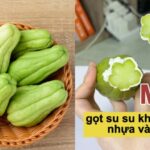For years, soaking raw vegetables in salted water has been a popular practice, believed to ensure food safety. However, this method is not as effective as once thought. To kill bacteria, the saltwater solution would have to be extremely salty, and such a concentration would draw out the water from the vegetable cells, causing them to break down and become mushy. This, in turn, creates an ideal environment for bacterial infiltration, resulting in a loss of sweetness and flavor. Saltwater is also ineffective in removing chemical residues.

Saline Solution Doesn’t Guarantee Bacteria Removal
Rinse with Running Water
A more effective method is to place the vegetables directly under a running tap and rinse them thoroughly. This allows the water to flush away surface dirt, bacteria, and parasites. Compared to soaking them in a basin and then transferring them to another container, this method ensures better removal of contaminants. Gently rub each vegetable to dislodge any dirt or parasites without damaging the produce. After rinsing, let the vegetables soak for about 10 minutes to enable the breakdown of any remaining toxins, and then rinse again with running water.

Use Alkaline Water for Disinfection
Bacteria cannot survive in highly alkaline environments. Therefore, after rinsing the vegetables under running water to remove surface dirt, soak them in alkaline water for 5-15 minutes. You can obtain alkaline water from an alkaline water machine or create a solution using a vegetable washing powder that increases alkalinity. For added safety, you may rinse the vegetables with clean water again after soaking them in the alkaline solution.
Peel Off the Outer Layer
The outer layer of vegetables and fruits is where most bacteria and chemical residues are found. By peeling this layer off, you can significantly reduce the risk of contamination. While this method does result in some loss of nutrients, it is an effective way to eliminate surface bacteria and chemicals. Fruits and vegetables that are commonly peeled include apples, pears, kiwis, cucumbers, carrots, eggplants, pumpkins, green squash, and turnips.
Blanch Vegetables Before Cooking
Blanching vegetables in boiling water before cooking can help break down toxins. This is especially important for vegetables that are prone to pests and chemical residues. Good candidates for blanching include green beans, cabbage, and broccoli. This method can also help remove pesticides and insecticides. Simply blanch the vegetables in boiling water for 1-3 minutes, depending on the type, and then rinse and cook as desired.
Allow Vegetables to Rest for a Few Days
Over time, natural light helps break down toxins in vegetables and fruits. Often, farmers harvest produce earlier than the recommended waiting period, which can result in higher levels of chemical residues. To mitigate this, refrain from consuming perishable goods immediately after purchase. Instead, let them rest for a few days to allow for the natural breakdown of toxins. The oxygen in the air, along with enzymes present in the produce, will initiate a reaction that degrades pesticide compounds. However, this method is only applicable to produce with a longer shelf life.
Wash Vegetables with Baking Soda
Baking soda, commonly used in baking and as a cleaning agent, is also effective in removing bacteria from vegetables. Mix baking soda with water and soak the vegetables in this solution for about 20 minutes before rinsing them again with running water.
The Ultimate Guide to Choosing Fresh and Meaty Shrimp: Secrets from the Coast
“Bề bề, or shrimp as it is more commonly known, is a delicacy that has gained a massive following. However, the art of selecting the finest shrimp is a skill that eludes many. With the right knowledge, one can easily pick the best of the best, ensuring a culinary experience like no other. This guide will ensure you become a master at choosing the tastiest shrimp, every time.”




































